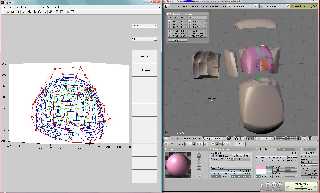On 24-2-2009 17:11, Mike Raiford wrote:
> For once in my life it looks like I properly interpreted something in
> Wikipedia and actually wrote the code to implement the psuedo-code on
> their page.
>
> Not only that, but based on what the psuedocode was saying, I properly
> surmised how to interpolate the resulting spline functions for each
> interval.
>
> Well, of course a spline is easy. Right?
>
> I just wish I knew a bit more of the underlying theory of how the
> coefficients were calculated.
>
> The article speaks of derivatives, so calculus must be involved. I'm
> gathering that the formulae in the algorithm were probably found by
> applying calculus to a 3rd order polynomial.
>
> http://en.wikipedia.org/wiki/Cubic_spline
>
>
This is what my screen looks ATM. On the left my dedicated bezier volume
editor and in blender a torso of a patient that is subdivided in
deformed cubes. Don't ask.
I prefer Bezier because it gives easy control and it is easy to switch
between control points and actual points on the curve. So when I need to
subdivide a line (or volume) I compute the points where the new line
must go through and convert that back to control points. This gives
absolute smooth transitions between the parts. Around the heart and lung
volumes there are discontinuities that I deliberately introduced, but
you can not see the seams in e.g. the front of the lower body, the lower
part is actually 5 by 4 by 2 blocks of rubber.
Post a reply to this message
Attachments:
Download 'knipsel.jpg' (263 KB)
Preview of image 'knipsel.jpg'

|




![]()